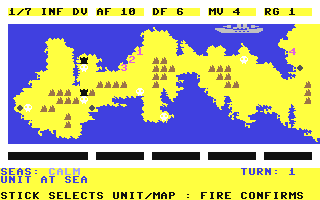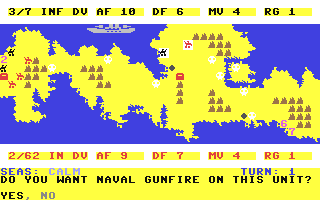|
Another
Second World War game; this time it's one of the Classic
Conflicts series of old PSS titles at reduced prices.
By
March 1945, the advancing Allies had reached the island
of Okinawa in southwest Japan. They wanted to capture
it to use as an airbase and harbour for their invasion
of Japan -- and the Allies considered then assault on
Okinawa a dress rehearsal for that invasion.
As
so often in the Pacific conflict, the Japanese resistance
and Allied losses were massive. Kamikaze pilots sank
36 Allied ships, 50,000 US troops were injured or killed,
108,000 Japanese died. In the face of these figures,
American commander Douglas MacArthur had to revise the
estimates for the capture of Japan itself -- after Okinawa
he expected to need five million men and suffer a million
casualties. So the Okinawa experience helped persuade
the Allies to use nuclear weapons and end the war without
another great battle.

But
in PSS's reconstruction this historical background is
merely an excuse for yet another game in precisely the
same mould as Falklands 82 and Iwo Jima.
If you've seen either of these, you've seen Okinawa.
Units
start at sea and are landed on the island. Then they
crunch around the landscape discovering enemy units,
supplementing their own fire power with offshore assistance.
There are minefields, long range sharpshooters and rules
that limit action in a turn to either moving or firing.
Everything that can possibly be the same as in Iwo
Jima and Falklands 82 is the same, nothing
is added or taken away. If you like Iwo Jima
you'll like Okinawa. End of review?
Well,
not everyone has played those other two island-bashing
games, so I'll proceed . . .
After
choosing from a generous eight difficulty levels, the
player (who leads the Allied forces) is presented with
an unexciting two-tone map of Okinawa. The scenery is
varied by mountains, minefields, villages (which are
not named, and are represented only by dots) and numbered
beach-heads (seven, dotted around the coastline). All
these features impose the usual kind of movement penalties
on units crossing them.
The
game proceeds in straightforward two-phase turns, with
the Allied forces getting their move first, after the
computer has invisibly positioned the Japanese defences.
The player has ten units on the first turn. Ten more
arrive on turn three if weather conditions are favourable
for landing, and on turn 16 -- by which time they are
very welcome -- another five arrive. All player units
start offshore and are positioned at one of the seven
beachheads which are arranged around three main points,
thus making a three-pronged attack possible.

The
computer automatically deals with each of the player's
units in turn during the action phase. On a unit's first
turn, it can both land and then move or attack; on subsequent
turns it can move or attack. Characteristic of the Okinawa-style
games is the way the player selects which enemy unit
to attack: the computer highlights the nearest possibility
and asks whether it is the target. On a negative response,
it goes to the next nearest. It will happily go through
all enemy units visible on the screen, paying no attention
at all to the range of the attacker.
This
is frustrating, because if you attempt to attack a unit
out of firing range the unit loses its turn and it's
easy to hit the joystick button and attack by mistake.
An
information panel at the top of the screen describes
the unit currently in use, giving its name, its firing
range, its movement range, its defence factor and its
aggression factor.
Sitting
on top of a minefield or being up a mountain increases
the defence factor, making it more difficult for enemies
to harm the unit. The aggression factor is an indication
of how effectively the unit can fight, and it's reduced
in combat -- when it reaches zero, the unit is eliminated.
You
can't examine enemy units at all, but when you decide
to attack one, all its values appear in a similar panel
at the bottom of the screen. During combat -- which,
like movement, occurs instantaneously -- you can watch
the aggression factor of both units go down.
The
Allied forces are divided into infantry, armoured and
artillery divisions. The infantry divisions have a range
of only one square, the armoured divisions have a range
of two, and the artillery can fire from a great distance.
The
Japanese are equipped only with infantry and artillery,
so if you range tanks against their men and pillboxes
they can't shoot back.
But
the Allies' major weapon is the gunship line, which
hovers offshore and rains naval gunfire on any part
of the island. After making an ordinary attack with
a land unit, the player can -- in the early turns of
the game, at least -- have a go with the big guns. And
in the early turns naval fire effectively provides two
attacks per turn on every enemy unit.
It
seems wise not to bother restraining your naval fire,
as it's quickly eroded by enemy action anyway -- at
the end of each turn the player has to watch, powerless,
as submarines stalk the gunships and planes attack them.
It's
difficult to plan a strategy in Okinawa simply
because the Japanese forces remain so well-hidden in
what's presumably the island's thick jungle, and since
the victory conditions declare that the Allies must
eliminate all Japanese forces on the island it's necessary
to search every corner of the map. All you can do is
send units off hopefully in random directions and keep
them moving until they fall over a Japanese division.
It then makes sense to stop and shoot, and, if your
unit survives, to carry on blindly in search of the
next victim.
And
the obvious broad approach -- a three-pronged assault
-- is suggested by the fixed beachheads. Little scope
remains for the strategic imagination of the player.
The
units appear as tiny and indistinct counters on a background
visually identical to Iwo Jima and the Falklands in
PSS's other similar games. And on a less-than-perfect
colour TV it's difficult to make out which side each
unit belongs to -- only colour distinguishes them.
|